
The fashion industry, a powerful global force, has been at the forefront of discussions on sustainability, especially in the wake of the G7 Summit. This summit, traditionally focused on economic policies, took a groundbreaking step by placing fashion sustainability at its core. In this article, we will delve into the crucial intersections of fashion and sustainability, exploring the commitments made at the G7 Summit and their potential impact on the future of the industry.
The Intersection of Fashion and Sustainability
2.1 The G7 Summit’s Emphasis on Climate Action
The G7 Summit’s pivot towards addressing climate change has placed sustainability high on the global agenda. With fashion being a significant contributor to environmental degradation, this shift has ignited conversations on how the industry can be a force for positive change.
2.2 The Role of Fashion Industry in Climate Crisis
The environmental impact of the fashion industry cannot be understated. From water pollution to excessive waste, the sector has, for years, operated in ways that harm the planet. The G7 Summit has brought this to the forefront, urging stakeholders to reevaluate their practices.
Sustainable Practices in the Fashion World
3.1 Ethical Sourcing of Materials
One of the key pillars of sustainable fashion is the ethical sourcing of materials. The G7 discussions emphasized the need for fashion houses to trace the origins of their materials, ensuring they align with environmentally friendly standards.
3.2 Eco-friendly Production Processes
Beyond sourcing, the production processes of clothing play a pivotal role. The adoption of eco-friendly manufacturing practices was a central theme at the Summit, encouraging the industry to minimize its carbon footprint.
3.3 Circular Fashion Economy
A shift towards a circular fashion economy, where products are designed to be reused and recycled, was championed at the G7. This move aims to reduce the alarming rate at which fashion items end up in landfills.
G7 Fashion Commitments
4.1 Key Initiatives Discussed at the Summit
The G7 leaders outlined several key initiatives during the Summit, ranging from setting emission reduction targets for the fashion industry to promoting transparency in supply chains.
4.2 Involvement of Fashion Giants
Major players in the fashion industry, including Kering, H&M, and Gucci, showcased their commitment to sustainable practices. These industry giants pledged to lead the way in implementing eco-friendly measures across their operations.
The Impact on Fast Fashion
5.1 Challenges and Opportunities
While the move towards sustainability is commendable, it poses challenges for the fast fashion sector. The demand for rapid production and low-cost items clashes with the principles of sustainable fashion.
5.2 Consumer Awareness and Choices
The G7 discussions highlighted the role of consumers in steering the industry towards sustainability. Increased awareness and conscious choices by consumers can drive a significant shift in the market.
Collaborations for Change
6.1 G7 Partnerships with Fashion Brands
The Summit emphasized the need for collaborations between governments and fashion brands. These partnerships are seen as crucial for implementing and monitoring the sustainability initiatives outlined during the Summit.
6.2 Shaping a Collective Consciousness
Beyond partnerships, the G7 Summit aimed to shape a collective consciousness within the fashion industry. The idea is to create a shared responsibility for the environmental impact of fashion and foster a culture of sustainable practices.
Challenges Ahead
7.1 Balancing Profit and Sustainability
One of the inherent challenges in the fashion industry’s sustainability journey is finding a balance between profitability and eco-friendly practices. The G7 discussions recognized this delicate equilibrium and explored ways to maintain it.
7.2 The Need for Stringent Regulations
To ensure widespread adherence to sustainable practices, the G7 leaders acknowledged the necessity of implementing stringent regulations. This involves holding fashion brands accountable for their environmental impact.
Inspiring Trends in Sustainable Fashion
8.1 Innovation in Materials
A positive outcome of the G7 discussions is the push for innovation in materials. Sustainable alternatives, such as plant-based fabrics and recycled fibers, are gaining prominence in the fashion landscape.
8.2 Technology and Sustainable Fashion
The marriage of technology and fashion is becoming a driving force for sustainability. From 3D printing to blockchain for supply chain transparency, technology is reshaping the industry’s approach to eco-friendly practices.
8.3 Influencers Driving Change
Influencers, with their massive reach, are becoming catalysts for change. The G7 Summit recognized the power of influencers in shaping consumer attitudes and encouraged collaborations to promote sustainable fashion choices.
The G7 Summit’s Influence on Fashion Capitals
9.1 Paris, Milan, London, and Beyond
Fashion capitals around the world are taking cues from the G7 Summit’s emphasis on sustainability. From Paris to Milan and London, the global fashion community is reevaluating its practices and adopting more sustainable approaches.
9.2 Local and Global Collaborations
The G7 Summit’s influence extends beyond international fashion houses. Local designers and brands are joining the movement, forming collaborations that bridge the gap between global sustainability goals and local fashion landscapes.
Steps for Individuals
10.1 Making Informed Fashion Choices
Individuals play a crucial role in the fashion sustainability narrative. Making informed choices about the brands they support and the products they purchase contributes to the broader shift towards sustainability.
10.2 Supporting Sustainable Brands
Choosing to support brands that prioritize sustainability sends a powerful message. Consumers can drive change by consciously opting for products from companies committed to eco-friendly practices.
10.3 Recycling and Upcycling
The G7 Summit underscored the importance of recycling and upcycling in reducing fashion waste. Individuals can contribute by embracing these practices in their own wardrobes, prolonging the life of clothing items.
Future Outlook
11.1 Evolving Fashion Industry Landscape
The G7 Summit marked a turning point in the fashion industry’s journey towards sustainability. The future holds promise as the sector continues to evolve, driven by a collective commitment to greener practices.
11.2 The Role of Next-Gen Designers
Next-generation designers are emerging as key players in shaping the future of fashion. The G7 discussions acknowledged the need to support and amplify the efforts of young designers committed to sustainable and innovative practices.
Conclusion
In conclusion, the G7 Summit’s spotlight on fashion sustainability signifies a paradigm shift in the industry. With commitments from global leaders and major fashion players, the journey towards a greener future has gained substantial momentum. The intersection of fashion and sustainability is no longer a niche concern but a shared responsibility embraced by governments, brands, and individuals alike.



